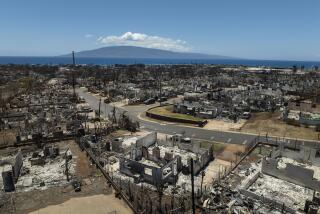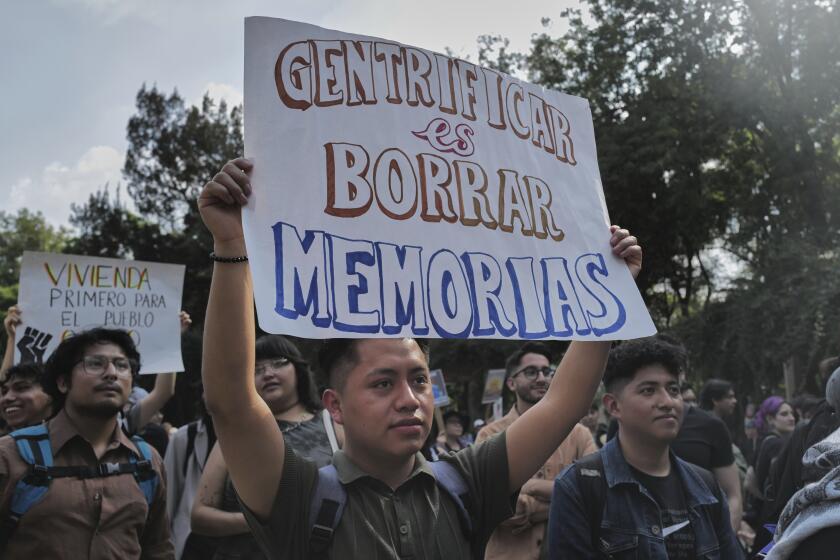Could this Hawaii community be the next Lahaina? Some residents fear a similar wildfire fate

- Share via
WAIANAE, Hawaii — When there’s enough rain, the mountain-framed expanse of vacant land behind Calvin Endo’s house looks like the lush and verdant landscape that makes tropical Hawaii famous. But in the summer, when the jungle of eyeball-high invasive grasses and spindly tree branches fade to brown, he fears it could become a fiery hellscape.
This isn’t Maui, where most of Lahaina burned down during a massive wildfire in August 2023. Endo’s duplex is in Waianae on the west side of Oahu.
But Waianae and Lahaina have a lot in common. They’re both situated on parched western island coasts, with road access pinched by topography, and are bastions of Native Hawaiian culture. Both have sections crisscrossed by overhead power lines atop aging wooden poles, like those that fell in high winds and caused the Lahaina fire.
There’s even a Lahaina Street through the heart of Makaha, Endo’s neighborhood along the Waianae coast.
“It can happen to us,” said Endo, who moved to the Makaha Meadows subdivision in 1980, soon after it was built. “We can have a repeat of Lahaina if somebody doesn’t do anything about the brush in the back.”
In recent days, two wildfires a few miles away, including a July 6 blaze that left a 94-year-old woman dead, proved his worst fears could become reality.
It’s been nearly two years since Lahaina provided a worst-case scenario of the destruction from wind-whipped flames fueled by overgrown brush. With 102 deaths, it’s the deadliest U.S. wildfire in a century.
In the months afterward, the number of Hawaii communities participating in the Firewise network, a nationally recognized program that helps communities with resources for safeguarding homes, more than doubled to 35 — but none in western Oahu.
Even though Waianae residents have long known about their wildfire risks, only now is one of its neighborhoods close to gaining Firewise status.
Communities become Firewise by organizing a committee, creating a hazard assessment, developing an action plan and volunteering hours toward reducing risk, such as removing overgrown brush. Firewise tracks a community’s progress, connects residents with experts, and provides ideas and funding for mitigation, workshops and training.
The U.S. Department of Agriculture Forest Service considers Lahaina and Waianae to be at much higher risk than other U.S. communities for a wildland fire, noted Honolulu Fire Department Battalion Chief Keith Ito.
“The weather, the winds, they’re pretty much identical,” he said. “With all that being said, I think that the high-risk wildfire potential is a statewide problem, not really specific to Waianae or Lahaina.”
Nani Barretto, co-director of the Hawaii Wildfire Management Organization, struggles to understand why fire-prone communities like Waianae have yet to join the Firewise movement. There are also no Firewise communities on the island of Kauai.
“Just because we are proactive in getting the word out, it doesn’t mean the right people are getting the information,” she said. “For Maui, it took a very devastating event for them to join.”
Organizing a community can be challenging because it requires residents to put in time and step up as leaders, she said.
Endo, who is a longtime member of the Waianae Coast Neighborhood Board, had never even heard of Firewise until recently.
A development called Sea Country, near the neighborhood that was recently ordered to evacuate during a wildfire, is close to becoming the fist Firewise community in Waianae, said Andria Tupola, a resident who also represents the coast on the Honolulu City Council.
The process got underway around 2018 but picked up momentum after Lahaina, she said.
Sea Country recently completed a hazard assessment and has planned some mitigation events, including a park cleanup in August, said Ashley Bare, the Firewise support specialist for Oahu.
Lahaina also provided the spark for opening an emergency access route in Waianae, Tupola said. Farrington Highway, the main artery along the coast, can get clogged with just an accident.
Military officials who control a mountain pass above Waianae started talking about letting civilians access the route after Lahaina, she said. During the July 6 fire, state and military officials were ready to open the road as a way out of the coast and into central Oahu, said state Rep. Darius Kila, who represents the area.
A Hawaiian homestead community in Waianae’s Nanakuli Valley is also trying to achieve Firewise status, said Diamond Badajos, spokesperson for the Department of Hawaiian Home Lands.
Home to the largest concentration of Native Hawaiians, Waianae is rich in Hawaiian culture and history. But much of the coast also struggles with poverty and homelessness.
Residents have grown accustomed to wildfires in the dry summer months, said Republican state Rep. Chris Muraoka: “It’s almost like if it doesn’t burn, something’s not right.”
However, Muraoka said he thinks communities along the coast would benefit more from fire-prevention and safety education in schools rather than organizing to be Firewise. Muraoka, who lives in Makaha, said communities in Waianae have unique needs that being Firewise might not address, including sections with neighborhoods that are more spread out than in Lahaina and blazes that are often started by arsonists or kids playing with fire.
Some residents already do what they can, especially with the dry season underway.
Endo often tries to clear brush on private property behind his home himself, to create a firebreak. Some properties in Waianae Valley use sheep to eat the overgrown vegetation.
Retired firefighter Shermaih “Bulla” Iaea recalls fighting blazes in the brush near Endo’s home and Makaha Elementary School.
In 2018, his farm burned down during high winds from a passing hurricane. He was using a herd of sheep on his property until wild dogs killed them in April. Neighborhoods banding together to become Firewise is another tool that will help, he said.
“There’s a 100% chance that will happen here,” he said. “I thought it would never happen to me. Now I’m trying to ring the bells. I’m trying to sound the alarm.”
Being one of the poorest communities in the state is a major factor preventing Waianae from becoming Firewise, said Kila, who lives near where the July 6 fire happened.
Before the summer, the Democratic lawmaker sent a letter to Hawaiian Electric and telecom companies urging “immediate and coordinated action” to address dangerous, sagging utility lines on aging wooden poles along the coast.
It’s not clear why Makaha ended up with a long street named Lahaina, which can mean “relentless sun” in Hawaiian. But like the west Maui town, it fits the sunny west Oahu neighborhood, which is home to the world-famous Makaha surfing beach.
Some neighborhoods above Lahaina Street are newer and have underground utilities, like Endo’s. But toward the ocean, older neighborhoods are laced by overhead power lines.
That worries Glen Kila, a Hawaiian cultural practitioner in Waianae, who is not related to Darius Kila. Power lines are blamed for sparking the Lahaina blaze.
“If that happens to Waianae,” he said, “we’re done.”
Kelleher writes for the Associated Press.
More to Read
Sign up for Essential California
The most important California stories and recommendations in your inbox every morning.
You may occasionally receive promotional content from the Los Angeles Times.













